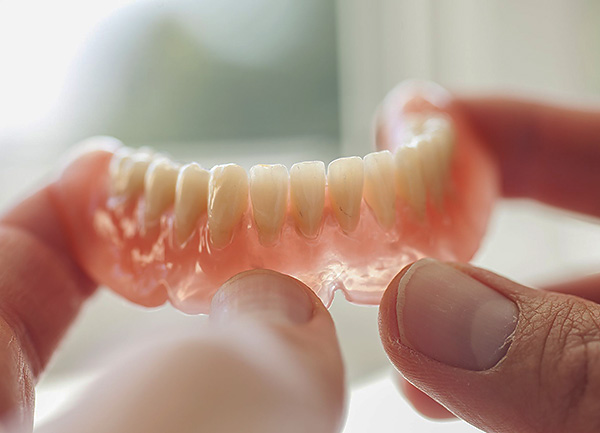
Today, people have a negative attitude to full removable dentures - many of them are associated with “false jaws”, which need to be removed at night and stored in a glass of water. It is believed that they are very uncomfortable to wear, violate diction and can even fall out of the mouth when eating or talking.
Well, all these “horror stories” are not without certain grounds, but to a large extent they are remnants of Soviet times, when the situation with the quality of manufactured dentures was far from the best.
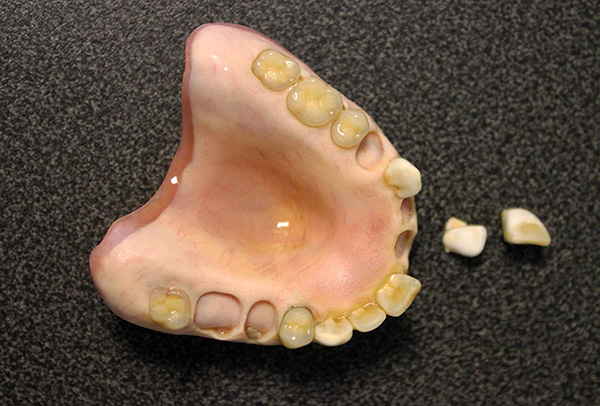
On a note
As the name implies, the complete one is a denture used in the complete absence of teeth in the oral cavity. Such prostheses are removable - when the patient can remove them (for example, for hygiene procedures), and conditionally removable - when the prosthesis can only be removed by a doctor with the help of special tools.
Fortunately, medicine does not stand still, and today even in the complete absence of teeth in the oral cavity, quite convenient orthopedic solutions can be found that will not only restore the ability to chew food normally, but also restore the long-lost beauty of a smile.
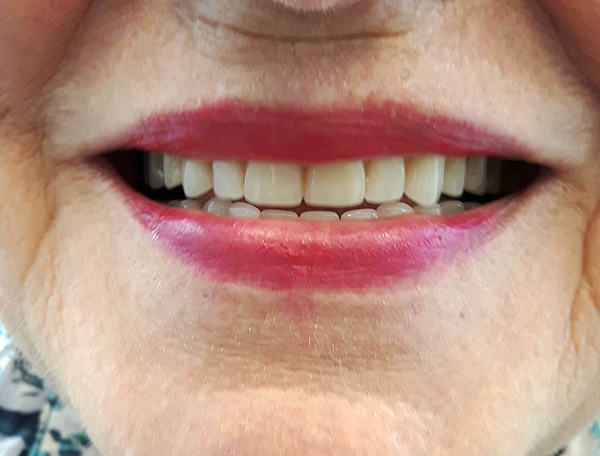
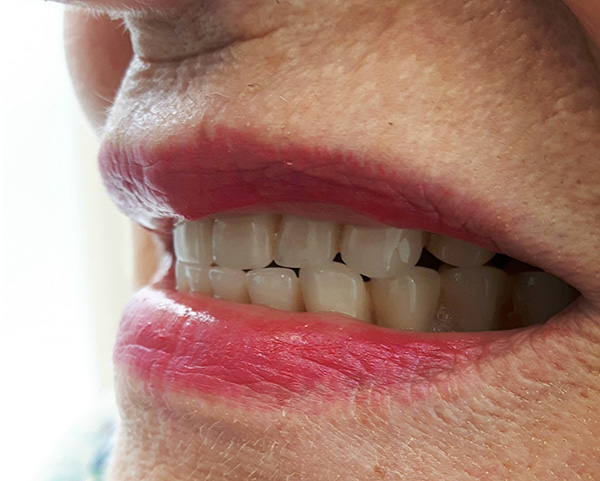
And last but not least, a full denture today does not have to be uncomfortable to wear, rub gums, cause a vomiting reflex or disrupt diction. For example, there are conditionally removable dentures without a sky, fixed on implants, which radically change the idea of the possibilities of prosthetics in “edentulous” patients. The combination of surgical and orthopedic treatment allows not only to improve the aesthetic qualities of prostheses, but also to ensure their reliable fixation with a significant improvement in the functional characteristics that provide comfort during eating, talking, singing, etc.
There are interesting options for prosthetics and without implantation, when for a relatively small amount you can get quite comfortable and outwardly attractive full denture.
All of this we will continue and talk more ...
What types of full dentures are in the arsenal of dentists
Full removable prosthetics is considered one of the most difficult areas of orthopedics - after all, the prosthesis needs to be somehow fixed in the oral cavity, where, it would seem, there is simply nothing to fix it. Partial dentures can be attached to the remaining (abutment) teeth, but with full dentures, alternative methods of fastening have to be found.
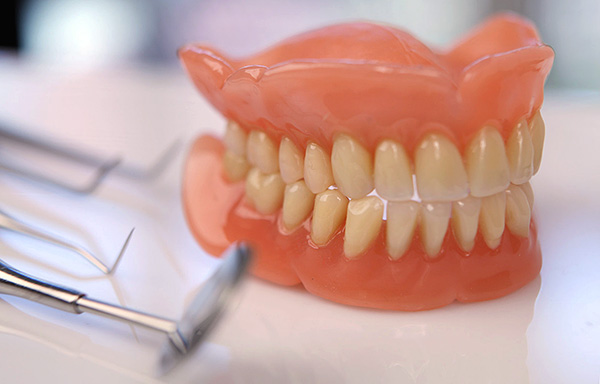
In this case, the orthopedic dentist has to consider the following nuances:
- Causes of tooth loss. For example, difficulties with full removable prosthetics may arise when teeth are removed against the background of severe generalized periodontitis (the situation is much simpler with the planned removal of relatively strong “roots” that cannot be restored);
- The time since the removal of teeth. If all teeth were removed quite a long time ago (for example, more than 10 years ago), then the degree of atrophy of the bone tissue of the alveolar process of the jaw will be significant, and the prosthetic conditions are worse than if it was carried out soon after the teeth were removed (1-2 years);
- Transferred and current diseases and operations on the jaws.A number of somatic diseases (especially severe ones) can worsen the conditions for a complete removable prosthesis, forcing the orthopedic surgeon to look for suitable alternatives. This applies primarily to elderly patients and people with combined pathologies (blood diseases, endocrine pathologies, oncology, musculoskeletal system, etc.).
In prosthetics, an orthopedic dentist takes into account the state of the temporomandibular joint (TMJ), mucous membranes (their flexibility, mobility), the degree of bone tissue atrophy, checks the condition of cords and scarring, and the depth of the sky (deep, medium, flat) and a number of other factors, which in the case of manufacturing a full denture can play a crucial role.
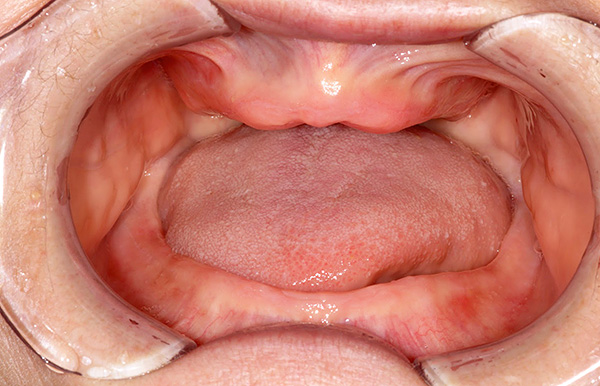
On a note
Having determined the conditions for a complete removable prosthesis (favorable or difficult) and financial possibilities of the patient, the doctor can suggest the best option for the future prosthesis, explaining the pitfalls of each of the possible options.
It is clear that not everyone will be able to afford full dentures without a sky with fastening on implants (that is, conditionally removable), even though they are as comfortable and aesthetic as possible.When choosing more budget options, it makes sense to give preference to products made from the most advanced materials, given, again, financial possibilities. The least comfortable prostheses made of rigid acrylic plastic.
Complete dentures of teeth, depending on the material used in their manufacture, are:
- Acrylic;
- Nylon;
- Silicone;
- Polyurethane.
All of these dentures are attached in the oral cavity due to the adhesive mechanism (they stick to the sky and gums - therefore, they are sometimes called dentures on suckers, although there are no suction cups as such).
The photo below shows freshly made nylon prostheses (full on the upper jaw and partial on the bottom):
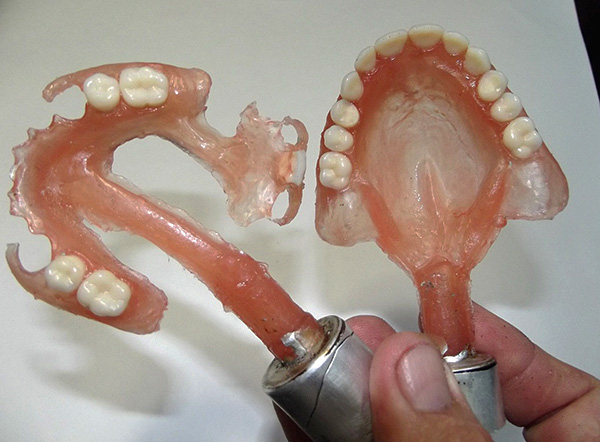
As for the types of attachment of conditionally removable prostheses fixed on pre-installed implants - here the following options are distinguished:
- Cover;
- Push button;
- With beam type fixers.
Each of dentures, ranging from the simplest (acrylic) to any conditionally removable, has its own advantages and disadvantages.The choice of option depends on the financial possibilities of the patient. It is important to keep in mind that regardless of the type of the selected full denture, the result of the treatment will directly depend on the level of training of the orthopedic surgeon, the dental technician and the material and technical support of the clinic.
From the practice of the dentist
If you go to order a denture in dentistry in the basement of a residential building, where the doctor accepts crowns from the “supplier” wrapped in a newspaper bag, it is difficult to count on first-class work. In very many cases, patients then cannot get used to such prostheses - due to manufacturing errors, they greatly interfere and rub the mucous membrane. As a result, the prosthesis is gathering dust on the shelf, since the patient does not wear it.
Full removable prostheses from acrylic plastic
The first technologies for the manufacture of full dentures made of acrylic plastic (AKP-7) were introduced in the early 1940s and are still widely used in the production of bases of various modern structures in prosthetic dentistry.
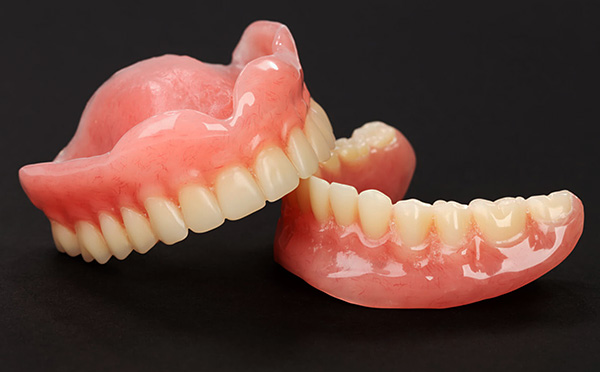
The basis is the basis of a complete denture on which the artificial teeth are fixed.On the upper jaw, the basis is a plate covering the mucous membrane of the hard palate and the alveolar process, and on the lower jaw - the mucous membrane of the alveolar part from the outer and inner side.
On a note
For the reason that the basis of a complete denture is a plate, such prostheses are also called laminar ones.
A complete denture does not have the ability to “cling” to the teeth, as they are completely absent. Therefore, with these structures, the effect of “sucking” to the sky is used on the upper jaw, as well as a certain anti-displacement effect provided by natural anatomical folds and the alveolar crest.
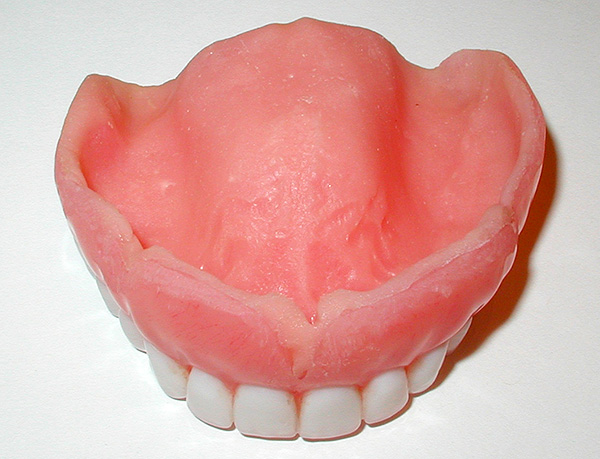
The prosthesis on the lower jaw does not have such a large “suction” area, as in the case of a prosthesis on the upper jaw adjacent to the sky. The design is retained due to the natural anatomical structures - largely due to the snug fit to the alveolar part.
Among the advantages of a complete removable acrylic prosthesis are:
- Low price in comparison with other designs;
- The possibility of repair for various types of damage;
- Ease of operation;
- Acceptable aesthetics with a relatively low check for the service.
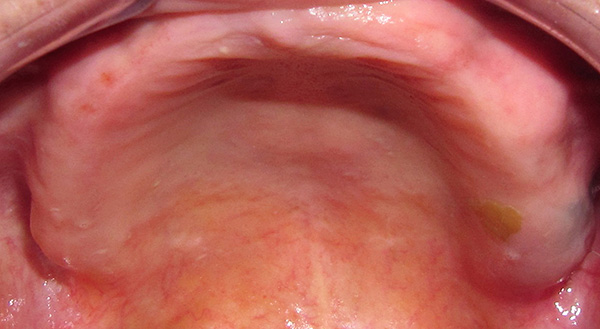
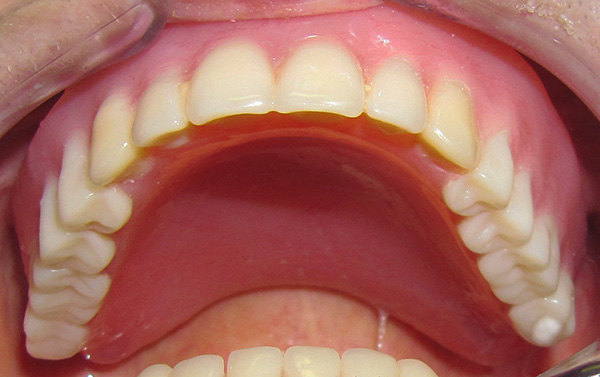
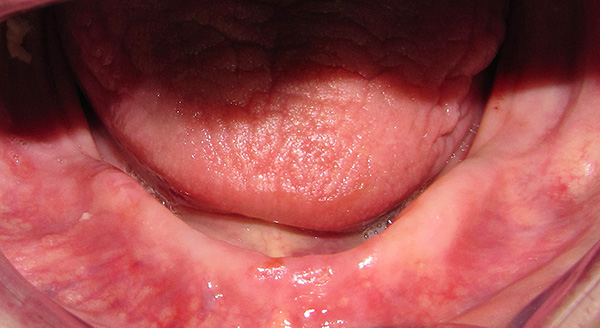
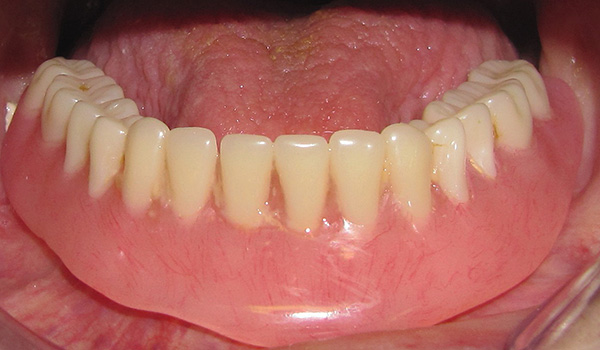
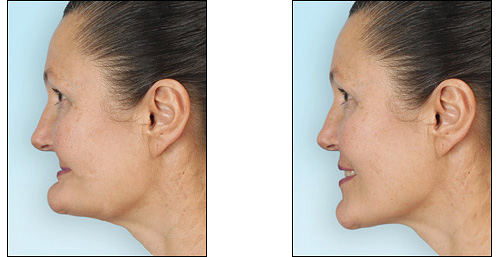
However, these prostheses are not without serious drawbacks:
- Allergy to residual monomer in acrylic bases (although in more expensive versions, there are ways to exclude monomer from plastic);
- The relative fragility of plastics and the risk of fracture with a large one-stage load;
- Low elasticity due to solid acrylic plastic;
- Frequent discrepancy of the relief of the inner surface of the base to the prosthetic bed of the mucous membrane (as a result, the reliability of fixation of the structure in the oral cavity decreases).
On a note
Acrylic plastic prostheses can be quite high-tech. For example, in 2015, technologies from the Swiss company CANDULOR appeared in Russia, offering a line of high-quality acrylic dentures. High aesthetics are achieved, including through the use of plastic, imitating the gum capillary system in detail.
The situation is similar with prostheses based on other polymers (polyurethane, silicone, nylon): there are budget products, and there are also more expensive and technological ones.For example, the material “Dentalur” based on polyurethane can be used to manufacture the base of a complete denture. He was awarded the Gold Medal of the Ninth International Forum of High Technologies of the XXI Century and other awards. Dental-based dentures are strong, quite elastic (due to this they are comfortable) and have a significant cosmetic advantage over standard dentures made from acrylic plastics.
Dentures made of nylon: their pros and cons
Full removable dentures made of nylon are today, perhaps, at the peak of their popularity over the past 10 years - and there are a number of reasons for this.
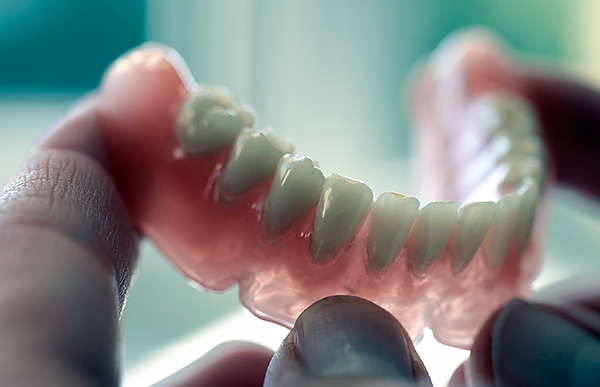
Here are some of the main advantages of nylon prostheses:
- Lack of allergy to the material. In the case of using a nylon prosthesis, unlike acrylic, there is no risk of an allergic reaction to the plastic monomer. Against this background, nylon greatly benefits compared with acrylic plastic, especially in full removable prosthetics;
- High aesthetic performance. This parameter could even be put in the first place. Compared with the same prostheses made of acrylic, nylon look “rich”, and, if it can be said so with reference to a full denture, it is gorgeous (it’s not for nothing that they are sometimes called invisible prostheses);
- Comfortable wearing. In most cases, it is easier to get used to and adapt to these prostheses than to standard acrylic ones;
- Resistant to mechanical damage. This quality is largely due to a certain elasticity of the prosthesis - it is not fragile, unlike acrylic plastic. Breaking a nylon prosthesis or somehow severely damaging it is quite difficult.
On a note
In fairness it must be said that an important role in increasing the popularity of nylon dentures is advertising. These products are significantly more expensive than acrylic prostheses, and it is of course more profitable for dental clinics if the patient chooses a prosthesis made of nylon.
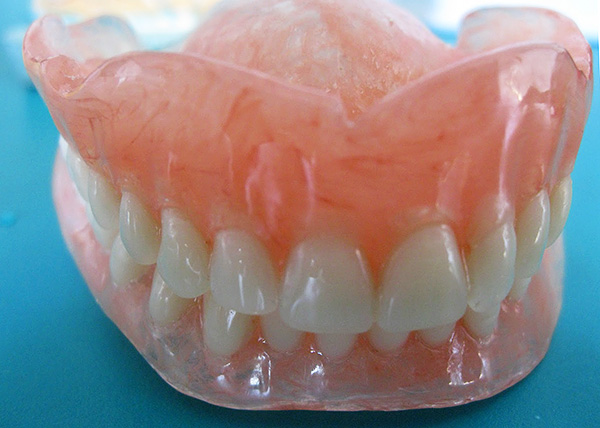
However, with all its advantages, nylon prostheses retain a number of drawbacks, which are useful to know in advance (in many respects, these drawbacks are characteristic of full dentures in general):
- Gradual atrophy of the prosthetic bed. With the complete absence of teeth, the alveolar ridges, experiencing an uneven load from the prosthesis, strongly “subside”. The process may take years, but is almost inevitable;
- Quite a quick loss of aesthetic qualities.Over the years, it may change the color of the prosthesis, which sooner or later will require replacement of the product;
- Repairing a nylon prosthesis (unlike an acrylic one) is almost impossible - it will be easier to make a new product.
It is interesting
Thanks to Acry Free prostheses, it was possible to combine the positive properties of acrylic and nylon prostheses, getting rid of a number of minuses that create obstacles to free prosthetics with acrylic and nylon. Acre-free has a good fit ("stickiness") to the mucous membrane, which allows to improve the possibility of fixation in the absence of teeth on the upper and lower jaw. The prosthesis is light, not allergenic, able to be adjusted, and most importantly, to a lesser extent provokes the phenomena of atrophy of the alveolar bone.
The photo below shows the Acry-Free prosthesis:
Features of prosthetics with conditionally removable structures
Against the background of the above, a number of well-founded questions arise:
- Are such methods of fixation of complete dentures, such as “suction” and anatomical retention (retention due to anatomical formations), sufficient for reliable fastening of the structure in the oral cavity and comfortableuse?
- Is it possible to somehow improve the reliability of fixation of the prosthesis and increase the degree of comfort when wearing it?
Active elderly people are especially important not only beautiful, but also reliably “seated” prostheses, which are able to chew almost any food normally.
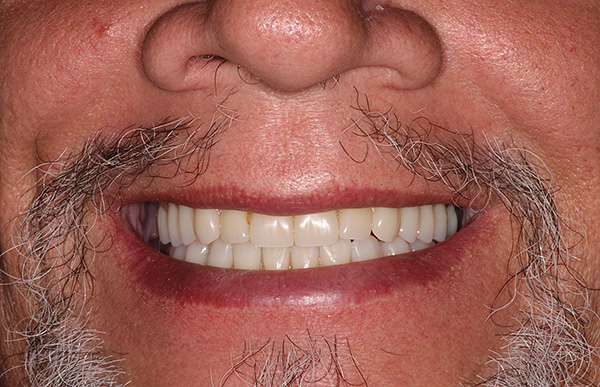
From the practice of the dentist
Not all patients have the patience to use a removable prosthesis, which, although it does not “rub”, does not “press”, does not “press”, but in the oral cavity all the same there is a feeling of the presence of a foreign object. And what is most unpleasant is that there is no certainty that this “foreign object” suddenly will not fall out of one's mouth one day, for example, when sneezing ...
Significant assistance in the reliable fixation of complete dentures is provided by conditionally removable prosthetics with the attachment of the prosthesis on implants. The use of dental implants makes it possible not only to significantly reduce the future denture in size, making it as comfortable and easy to use as possible, but also completely eliminates the option of “sticking” the denture during chewing or talking.
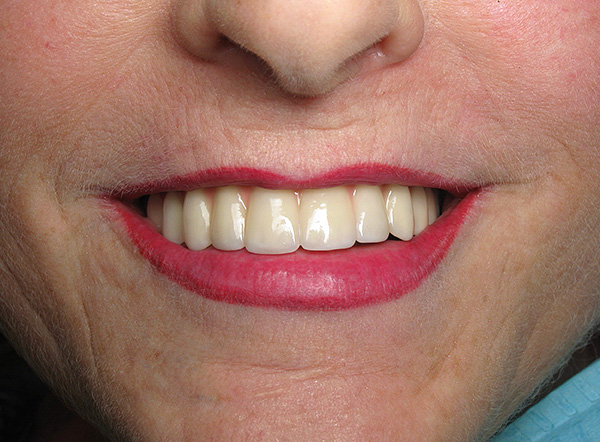
At the moment there are different types of implant systems in order to fix a removable prosthesis:
- Classical - classical implants are placed in the spongy bone of the alveolar process. Usually, prosthetics stretch for several months while implants take root in the bone tissue;
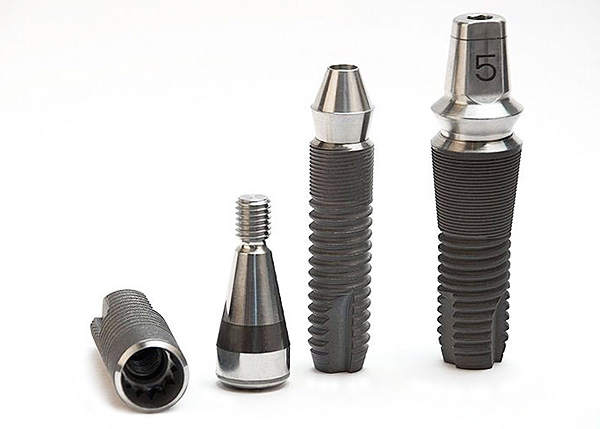
- Basal - in the dense bone, which is located deeper than the spongy, basal implants are installed. In this case, even with significant atrophy of the bone of the alveolar process, it is not necessary to increase it (that is, sinus lift surgery is usually not required);

- Mini-implantation - in this case, narrow mini-implants are installed in the bone, designed to fix the prosthesis. Unlike classical and basal implants, mini-implants are not designed for a significant load, so a full prosthesis should distribute the load also to other parts of the oral cavity (palate, gum).

According to the methods of fixation of complete dentures on implants, a significant niche in orthopedic dentistry is occupied by:
- Microlock fixation;
- Beam fasteners;
- Magnetic clips;
- Spherical (spherical) types of attachment;
- Silicone rings;
- Combined options.
On a note
Pre-installation of implants makes a complete removable prosthesis as reliable as possible andcomfortable, especially in difficult cases (with significant atrophy of the alveolar crest, cords, etc.), when wearing almost any prosthesis (acrylic, nylon, Acre-free) promises endless trips to the orthopedic dentist, suffering during addiction and The most extreme option is to send the “puller” to the shelf.
Beam fixation on classical or basal implants is considered one of the most reliable and durable - it provides a reliable fit and fixation of the prosthesis even under non-ideal prosthetic conditions.
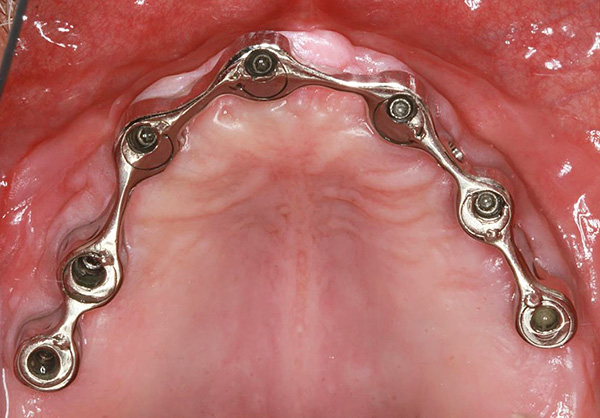
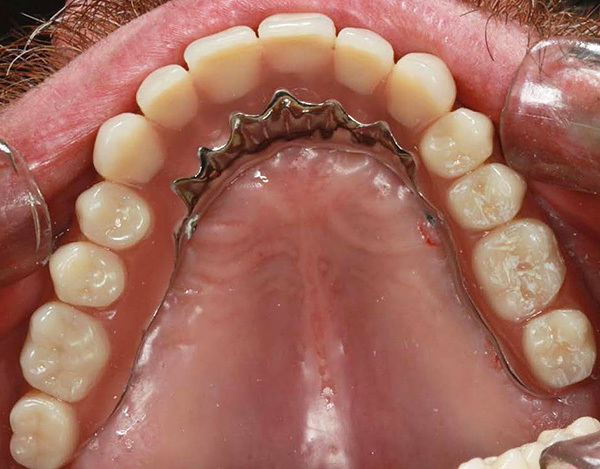
Magnetic clamps (attachments) hold the prosthesis due to magnetic attraction. This option of fastening compared to other methods does not provide maximum reliability in holding the prosthesis.
As for the spherical attachments - some experts argue that the materials of this type of attachment tend to abrasion and failure (although there are systems that have replaceable washable parts - their replacement does not require much time and money).
Currently, mini-implantation is being actively used (and promoted in advertising by many clinics) to fix dentures on the edentulous jaw, however, a number of specialists believethat mini-implants are suitable only for temporary prosthetics, but not for permanent. Dental mini-implants differ from other simplified surgical and orthopedic protocols, as well as low cost. They can be installed even in those clinical cases where the use of classical implants is impossible without additional preparatory operations that can be difficult to tolerate or be contraindicated, especially in old age.
As for implants installed on implants, they can be made from all the same materials as removable dentures (usually nylon, Acri-Free, polyurethane).
Principles of manufacture of complete dentures and their installation in the oral cavity
One of the most important stages of prosthetics is the examination of the patient - it includes the study of the state of general health, possible allergies to certain drugs (materials), as well as the assessment of the state of the prosthetic bed in many ways.
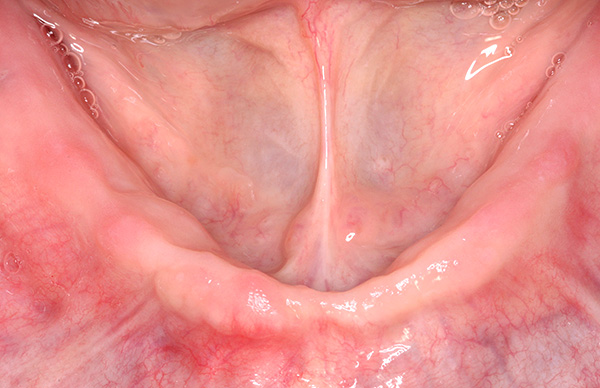
Much attention is paid to assessing the degree of atrophy of the alveolar processes in the upper and lower jaw. The state of the mucous membrane is checked: mobility, color, "friability",condition of wrinkles along the ridge and other points. All this allows you to specify the important nuances of the design of the future prosthesis.
Below, using the example of a complete removable prosthesis made of acrylic plastic, the main stages of manufacturing this design are considered:
- Taking impressions and sending them to the laboratory to the dental technicians;
- Casting models;
- Making individual spoons (as needed);
- Creating a base with bite rollers;
- Determination of central occlusion using these wax rolls;
- Production of the basis for bite rollers (relief modeling);
- Setting teeth on the glass or on the plane;
- Gypsum model;
- Wax evaporation;
- Mixing and "packing" plastics;
- Finishing the denture;
- And finally, the delivery of the prosthesis to the patient - fitting in the oral cavity.
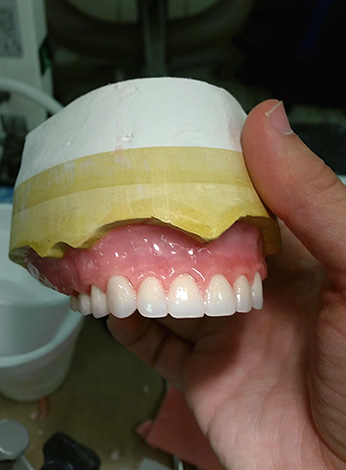
It is interesting
Standard removable acrylic prostheses are made as follows: a liquid material is poured into the mold, where it is cured and cured. In the process, a large shrinkage of the material occurs, that is, its reduction in volume, as a result of which the prosthesis may not correspond to the prosthetic bed and may not accurately fit to it.In addition, the formation of micropores often occurs in the base, where in the future bacterial plaque will accumulate, provoking an unpleasant odor from the mouth.
A new method of creating acrylic prostheses using the IVOCAP system (Ivocap) from IVOCLAR (Switzerland) has made it possible to eliminate these problems by injection molding - the plastic is dosed with capsules and pressed under constant pressure and temperature. With this method of manufacture, the characteristics of the prosthesis are improved.
How to care for a denture to serve longer
After the patient receives a complete denture, the orthopedic surgeon always gives explanations about the nuances of his fixation in the oral cavity, and sometimes also teaches special speech exercises for quick adaptation to the product. Much attention is also paid to the rules of care for the prosthesis in order to increase its service life and minimize the loss of aesthetics.

It is important to know
Full removable dentures need daily cleaning, if only because they fit tightly to the mucous membranes and create areas that are poorly bathed in saliva.
The most common means of care for complete dentures:
- Cleansing tablets and powders (dissolved in water, after which a prosthesis is placed in the resulting solution);
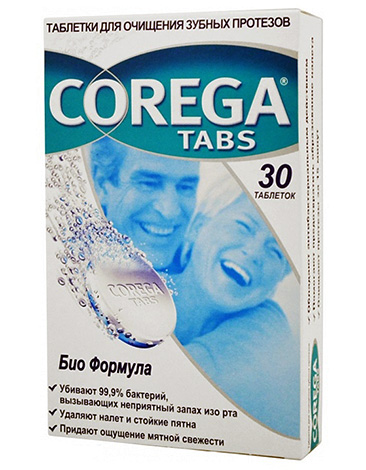
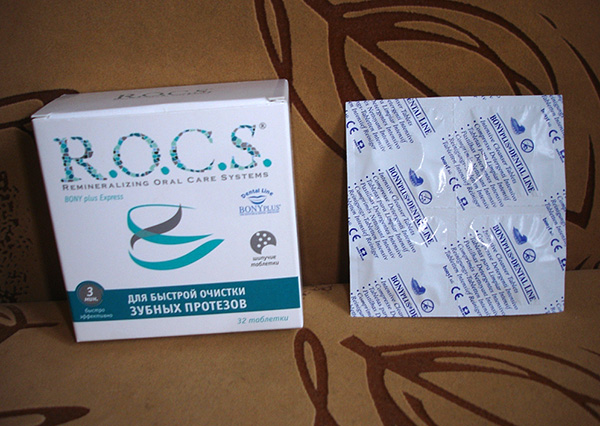
- All sorts of ready-made solutions for the disinfection of dentures;
- Brushes to clean the denture;
- Toothpastes (standard ones are suitable, the main thing is not to use whitening highly abrasive pastes, as they can lead to abrasion of plastics).
Standard prosthetic care scheme:
- In the morning and in the evening, clean the food particles and bacterial plaque with a toothpaste and brush. At the same time, attention should be paid to cleaning not only the external surface of the prosthesis, but also the internal one, which is in contact with the gum and palate;
- Rinse your mouth after each meal and rinse the prosthesis under running water;
- Clean the prosthesis before bedtime with special solutions.
For some, it may seem surprising, but plaque and even tartar can also be deposited on dentures, so at least once a year it is useful to apply for preventive examinations. In case of significant contamination of the prosthesis, it is given to the dental laboratory, where the dental technician processes the prosthesis to an ideal condition.
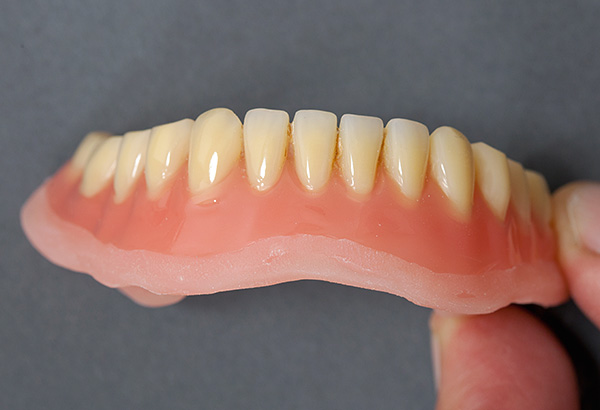
Proper care of the prosthesis is the key not only to its long service, but also an important factor that determines the health of the mucous membranes, the absence of putrid odor from the mouth and the preservation of aesthetic characteristics (You do not want the artificial teeth of the prosthesis to turn brown, and the plastic to get an unnatural shade for the gums?)
How much is now a complete "puller"?
The cost of a complete denture is determined by a number of factors, among which the most important are the following:
- The material from which the denture is made (for example, an acrylic denture will be cheaper at a price than a nylon one);
- The presence in the clinic of its dental laboratory;
- Staff qualification;
- The geographical location of dentistry (prices in megalopolises are usually higher than in smaller cities);
- Individual patient characteristics (some anatomical nuances may complicate the manufacture of high-quality prosthesis).
To put it simply, today, only complete dentures made from ordinary acrylic plastic are relatively cheap - their use is considered the most budget-friendly option for full prosthetics.
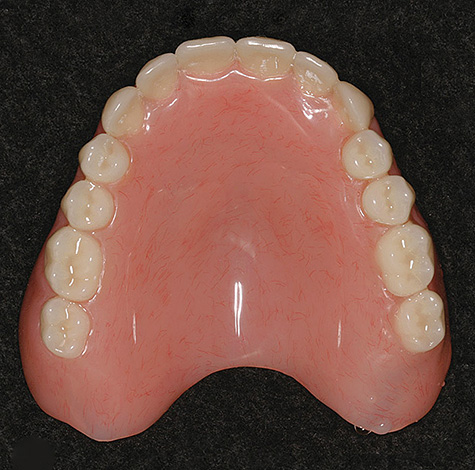
Feedback
“I have been wearing an upper and lower acrylic prosthesis for only 2 weeks. The top one is sitting nicely, and the bottom one is walking. One has only to move the tongue, as the prosthesis rises immediately. I do not even know what it is connected with ... "
Inna, Moscow
Here are examples of prices for full-removable dentures in one of the clinics of St. Petersburg:
- Acrylic prosthesis - from 8 thousand rubles;
- Prosthesis from Dentalur - from 12 thousand rubles;
- Plate prosthesis (Ivoclar plastic) - from 14 thousand rubles;
- Nylon prosthesis - from 20 thousand rubles;
- Nylon prosthesis (materials made in Germany), Acre Free - from 25 thousand rubles;
- Removable prosthesis (materials made in Switzerland) "Kandulor" - from 40 thousand rubles.
The combination of orthopedic and surgical care many times increases the price of the patient’s treatment in the absence of teeth - when it comes to conditionally removable prosthetics, the cost of the actual implantation makes a major contribution to the final price.
If you have personal experience of using a removable denture in the absence of teeth on the upper or lower jaw, please share the information by leaving your review at the bottom of this page (in the comments field).
What is important to know about nylon dentures (they don’t talk about it in advertising)
Interesting nuances of full removable layout

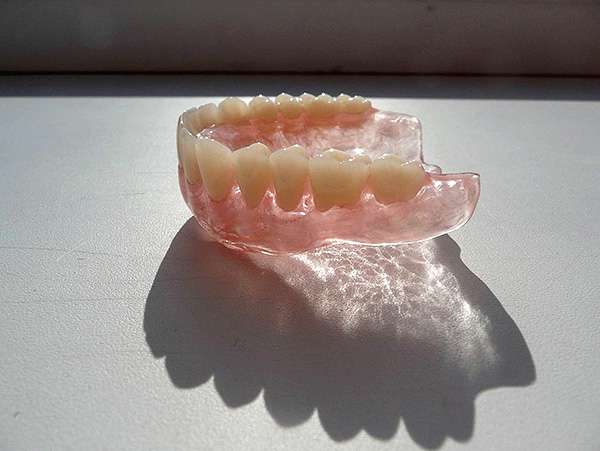
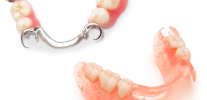
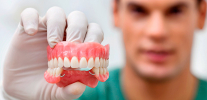
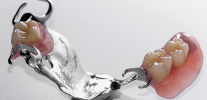
I have a prosthesis and the upper and lower. They gave it to me 20 years ago. At night I never take off, brush my teeth like ordinary teeth. I never flew, never lisped. The only thing is that when the seeds were snapped, there was a scratch in the tooth. So I am very pleased with my teeth. And yet, 20 years ago, it was very cheap. And now, not everyone can insert their teeth.
And what kind of prosthesis did you put?
On May 15, 2018, she inserted an acrylic removable denture on the upper jaw. My impressions: when talking, the prosthesis “walks”, I lisp, the bite is changed and I am not comfortable. The cost of the prosthesis is 20,000 rubles. The money is not mad, but I really want a comfortable denture. I think maybe in another clinic order a new one. Prosthetic in TsMSCH-38.
I wanted to insert a prosthesis in the upper jaw. Alfa Bank refused. Only it was necessary to 30,000.
She put acrylic denture - horror! Everything hinders, I want to quickly remove.
For 12 years I have been wearing removable dentures. At first they were partial, but now I will order full ones, since there are no teeth left. My prostheses are acrylic. Perhaps because my gag reflex is poorly expressed, I did not get used to them for long, somewhere a couple of weeks, although the doctor warned that I will get used to the month for sure. Now I think which material to choose. Still, acrylic hard enough. Although I had no particular problems with their wearing. Seeds, of course, did not click, but chewed enough solid food.